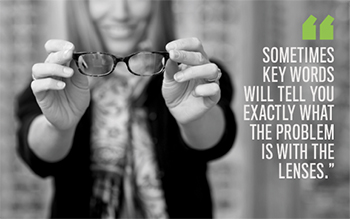
Help new progressive wearers with their lenses, and you’ll save time (and win loyal customers for life)
This article originally appeared in the June 2015 edition of INVISION.
Free-form progressives are an amazing addition to the lens world, but we know that some patients face a steeper learning curve than others in adapting to their new multifocal eyewear.
Advertisement
Here’s the good news: Knowing how to effectively troubleshoot a new progressive wearer’s glasses gives you a golden opportunity to bond with that person for life. Instead of passing the patient straight on to the doctor, see if you can troubleshoot lenses yourself. If you can, you’re going to have a fan who will likely come back to see you for their next pair of glasses … and the one after that.
I have developed a triage form for our office that allows us to troubleshoot lenses efficiently and effectively so we can get our patients seeing sharply. When a patient is having trouble seeing out of her progressives, it’s usually because one of these factors:
➤ The frame could be poorly adjusted.
➤ The lenses could be mismeasured. An incorrect pupillary distance or seg height measurement means the patient has to tilt her head up and down or side to side to get clarity.
➤ A defect in a lens treatment may lead to foggy or blurry vision.
➤ The base curve could be different between the old and new pair of glasses.
Advertisement
➤ The patient’s prescription could be off. She may need to see the doctor again in order to be re-refracted.
➤ The patient may have unrealistic expectations.
➤ The patient may be a non-adapt to progressives.

Start your troubleshooting by asking the patient what her chief visual complaint is, and whether the visual issue is in one eye or if both eyes are affected. Pay attention to what the patient is saying. Sometimes key words will tell you exactly what the problem is with the lenses, and that will save you both time.
Advertisement
Next, look at how the frame is adjusted on the patient’s face. If the frame is not sitting properly, the patient could be looking out of the wrong portion of the lens, which will definitely lead to difficulty seeing well.
If the adjustment looks OK, then compare the patient’s old lenses with her current pair. Is the base curve different? Is their seg height in a different spot? Is there a vertical imbalance? All of these are good questions to ask yourself when comparing the new and old lenses.
After this, you will want to read the new lenses and verify the prescription and measurements. We are all human, and sometimes during the lens check-in process, we can miss things. We want to be sure that everything we ordered on the lenses came back properly from the lab and that an incorrect measurement isn’t the reason for the patient’s inability to see well.
If all still looks OK to this point, then try to learn whether the patient has any medical issues that may be affecting vision. Does she have diabetes, cataracts, macular degeneration or dry eye? All of these conditions can affect how a patient sees.
If you’ve done all this and there’s still an issue, you can then pass the patient on to the doctor — along with your troubleshooting notes. The notes may give clues to help the doctor discover what’s going on, and they also let both patient and doctor know you have done everything you could to assess the lenses. Reassure the patient that if a prescription or medical condition is keeping the patient from adapting to the lenses, the doctor can properly diagnose the issue.
A final note: The best progressive troubleshooting happens at dispense. So every time you dispense a pair of multifocal lenses, spend some time with the patient to help her learn how to use them. That way, you may prevent a later troubleshooting visit, and you’ll build the patient’s confidence and trust that she made a good choice with her new eyewear.
Katie Lauver is a certified optician at Vision Source in Asheville, NC, the office of Dr. Michelle Reames, where she manages the optical, styles patients and troubleshoots eyewear. A version of this column appeared first on her blog at dailyoptician.com/katie-lauver/.